The Himalaya's hidden 'paradise valleys'
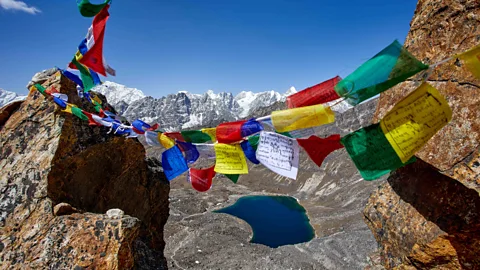 Stuart Butler
Stuart ButlerAccording to Tibetan Buddhists, their location will only be revealed at very specific moments in time when the world is under enormous stress and in danger of destruction.
Looking out of the monastery doorway at columns of rock and spires of ice soaring 7,000m into the heavens, the Buddhist monk smiled and said, "I am home. In my paradise." He then turned his attention back to the classroom where he was teaching young novice monks. I thanked him, shut the door behind me and walked away from the monastery. Away from the small village of Thame with its sturdy stone houses and fields of barley and potatoes. Away from the huge Himalayan peaks. And away from the beyul.
An integral belief in the Nyingma school of Tibetan Buddhism, established in the 8th Century and the oldest of the four different schools, a beyul is a place where the physical and spiritual worlds overlap. Specifically, they are hidden paradise valleys whose location will only be revealed at very specific moments in time when the world is under enormous stress and in danger of destruction through war, famine or plague. At such times, it's believed, a beyul becomes a refuge in an unstable world where everything lives in harmony.
"A beyul is a sacred place and sanctuary to which lamas (teachers of Tibetan Buddhism) could lead people in times of strife and trouble," explained s Klatzel, author of several books on Himalayan and Buddhist culture, including Gaiety of Spirit – the Sherpas of Everest.
But a beyul cannot be entered by just anyone, she added. Only a true Buddhist with a pure heart who has overcome enormous trial and hardship can enter a beyul. For Nyingma Buddhists, trying to enter a beyul when all the above conditions are not met is likely to lead to death.
As the author of a number of guidebooks to the region and a regular visitor to the Himalaya and Tibetan regions, I found it fascinating that somewhere among the folds of the Himalaya might be hidden lands revealed to a worthy few in times of calamity. Before heading up into the mountains to find out more, however, I asked Klatzel for some background on how the beyuls came to be.
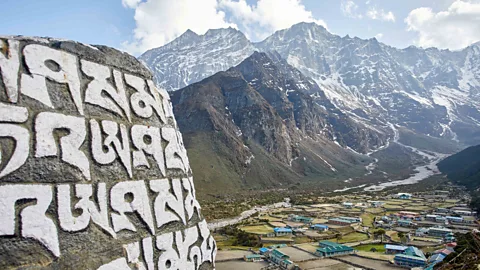 Stuart Butler
Stuart ButlerShe explained that the beyuls were created by Pasambhava (Guru Rinpoche, or The Lotus Born One), a tantric Buddhist Vajra master who was thought to be instrumental in spreading Buddhism throughout Tibet and the Himalaya around the 8th or 9th Centuries.
"During his travels in the Himalaya, Pasambhava realised that times of strife would come, so he used his spiritual powers to purify and 'hide' certain valleys and wrote texts describing their locations and the conditions for entering them," she said. These texts were hidden in caves, inside monasteries and behind waterfalls throughout the Himalaya and could only be discovered by lamas at times that were predetermined by Pasambhava.
Nobody knows exactly how many beyuls there are, but 108 is the most widely accepted figure – though most are yet to be revealed. Most of the areas that have been located are on the south side of the Himalaya, which is greener, wetter and more fertile – more "paradisical" – than the often sterile and harsh Tibetan plateau.
Some of these beyuls – such as in Sikkim in north-east India and the Helambu, Rolwaling and Tsum valleys in Nepal – have been known about by Buddhist practitioners for centuries and are now dotted with villages and towns. Then there are those where the location is known but is inaccessible to most. This is because a beyul can be both a physical place and a spiritual place. It's said that a person could even be stood in a beyul but not be inside it.
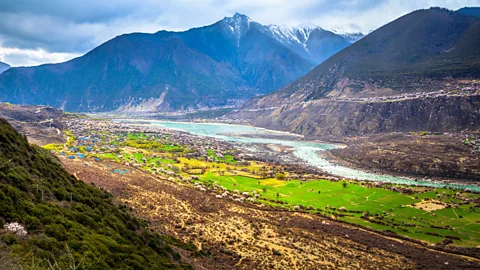 Feng Wei Photography/Getty Images
Feng Wei Photography/Getty ImagesIt might be easy to consider the idea of a hidden land as something out of a fairy tale, but ancient scrolls giving the details of beyul have indeed been found. Take for example, Beyul Pemako. Located in what is today the remote north-east Indian state of Arunachal Pradesh, the gateway to the revered beyul was noted to be hidden on cliffs behind a waterfall in the most inaccessible part of the Yarlung Tsangpo Canyon, the deepest canyon on the planet, which remained a blank spot on maps until very recently. Nobody even knew if a waterfall existed there. But in the early 1990s, a team of Buddhist practitioners, led by Buddhist scholar Ian Baker – who later wrote about the experience in his book The Heart of the World – finally penetrated the area, where they did indeed discover a high waterfall hidden inside the canyon.
Just as the beyuls themselves seem to be more than legend, so are the stories of a grisly end if you try to enter one when the time isn't right or if you heart is not as pure as you think. In 1962, a respected Tibetan lama named Tulshuk Lingpa claimed to have found a map that would lead to the Beyul Demoshong, the gateway of which was rumoured to be somewhere on the slopes of Mount Kanchenjunga, the world's third highest mountain.
He travelled to the mountain with around 300 followers. As recounted in the book A Step Away from Paradise by Thomas K Shor, survivors of the event recounted that Lingpa and a few others who'd gone on ahead to do a reconnaissance of the route saw a series of bright lights calling them toward a gateway. But rather than entering the beyul, Lingpa returned to gather up all his followers. Unfortunately, instead of crossing a magical threshold into a paradise valley, most of the group – including the lama – were killed by an avalanche.
Others have had more successful attempts to enter a beyul. The Sherpa people are one of those. Today, these renowned climbers, porters and trekking guides are intimately associated with the Nepalese Himalaya, and Mount Everest in particular. But they haven't always lived in the southern shadow of Everest. For most of their history they lived in the Kham region of eastern Tibet (today a part of China's Sichuan province) but, back in the 15th Century, widespread turmoil and conflict in Tibet turned the Sherpa world upside down.
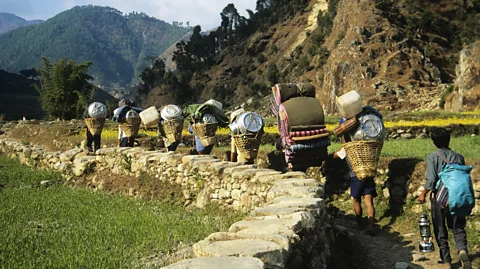 Image Source/Getty Images
Image Source/Getty ImagesIt was then that Lama Sangya Dorje, a Master Tibetan Buddhist, decided that the time was right to "unlock" the Khumbu Beyul. He led the Sherpas over the daunting Nangpa La (5,716m) and into a well-watered land where they could grow crops and graze their yaks in peace. The Sherpas had arrived in the Khumbu (the name given to the area surrounding the Nepalese side of Mount Everest) and, compared to where they'd just come, from it was a vision of a high-altitude paradise.
Nowadays, the Khumbu region welcomes thousands of international visitors each year who come to hike to the famed Everest Basecamp, but few people I met when I visited seem interested or aware that they were in a beyul.
However, there are some corners of the Khumbu region where the spirit of the beyul remains strong. Perched on a steep, forested slope, the Lawudo Gompa is considered one of the most sacred spots in Nepal's Bhote Koshi Nadi valley, located two valleys west of Everest Base Camp.
"Most people think there are just four valleys in the Khumbu region. But that's not true," said Dawa Sangye Sherpa, an 82-year-old nun who has been living at the gompa (a small Tibetan monastery) for more than 50 years. She'd brought me tea and biscuits almost the moment I'd arrived and had readily agreed to tell me more about Lawudo's connection with the Khumbu Beyul.
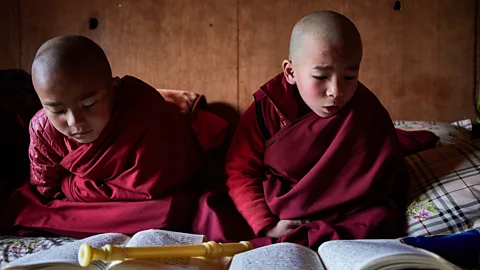 Stuart Butler
Stuart Butler"Behind the gompa is a large cliff called Dragkarma and in the cliff is a gateway that leads to a secret fifth valley," she told me. "That's the heart of the beyul."
When I asked if I could see the cliff, Dawa Sangye smiled and shook her head. "But let me show you something else," she said. Leading me behind the main prayer hall, the nun flung open a small door to reveal a room built into and under a rock overhang. Inside, the rock ceiling had been painted the blue of a summer sky and at the far end of the room was a small shrine with a statue of Pasambhava. At his feet, were offerings left by visitors: a small box of Royal Britannia digestive biscuits, a packet of noodles and some dried flowers.
"This is where Pasambhava meditated and where he blessed the Khumbu and turned it into a beyul," Dawa Sangye said. Even though I'm not a Buddhist, I found myself running my hand over the cave walls with a sense of wonder flowing over me.
Perhaps seeing my smile, the nun suggested that I go to the village of Thame further up the valley. Situated just at the point where farmland turns to highland yak pastures, Thame monastery, she told me, is considered one of the oldest monasteries in the Khumbu and a place of great spiritual significance. Some even say that it's the spiritual heart of the Khumbu Beyul.
The walking trail from Lawudo to Thame spiralled down cliff faces and crept along a canyon formed by mighty mountain peaks. Then, quite suddenly, the land peeled back to reveal a wide-open valley with the village of Thame at the far end. Pushing open the doors to the main prayer hall of the Thame monastery, I found three elderly monks chanting words written onto yellow-tinged parchments. Breaking off from his recitals, one of them waved for me to sit on the bench next to him.
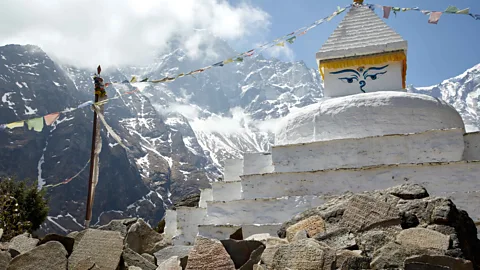 Stuart Butler
Stuart Butler"Sometimes, when we are reciting our prayers here, Pasambhava appears to us," he told me in a hushed tone, adding that Pasambhava's spirit would tell them that the work they were doing – and the prayers they were offering – were bringing good to the world.
A short time later, I ed the classroom doorway where the Buddhist monk had said, "I am home. In my paradise." Whether or not there were hidden valleys in the Himalaya, it seemed clear that these monks had found their place of peace.
As I left, I was reminded of something that Klatzel had told me before I'd set out: "A beyul is more than just a place, it is a state of mind," she'd said. "Beyul are reminders to prepare ourselves for challenges ahead by developing a calm and steady state of mind that becomes our inner beyul, our inner sanctuary."
--
more than three million BBC Travel fans by liking us on Facebook, or follow us on Twitter and Instagram.
If you liked this story, sign up for the weekly bbc.com features newsletter called "The Essential List". A handpicked selection of stories from BBC Future, Culture, Worklife and Travel, delivered to your inbox every Friday.
